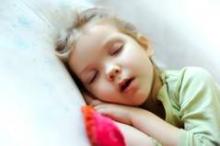Sleep-disordered breathing in infancy and early childhood increases the likelihood of problematic behavior in later childhood, findings from a large, population-based, longitudinal study suggest.
The findings, based on an analysis of data from more than 11,000 participants in the Avon Longitudinal Study of Parents and Children, underscore the importance of addressing sleep-disordered breathing symptoms as early as the first year of life, Karen Bonuck, Ph.D., of the Albert Einstein College of Medicine, N.Y., and her colleagues reported online in the March 5 issue of Pediatrics.
Parental reports on children’s snoring, mouth breathing, and observed apnea identified five early and five late symptom trajectories, or clusters, among the children in the study. The early clusters included those with symptoms arising between 6 and 42 months of age, and the later clusters included those with symptoms between 6 and 69 months of age. The later clusters represented extensions of early clusters.
After researchers controlled for 15 possible confounders, including factors such as fish intake, Family Adversity index, mother and home score, smoking and alcohol use during pregnancy, and race, these clusters predicted approximately 20%-60% increased odds of problematic behaviors at age 4 years, and approximately 40%-100% increased odds of problematic behaviors at age 7 years, as measured using the Strength and Difficulties Questionnaire (SDQ). Behavioral problems assessed included hyperactivity, conduct problems, peer difficulties, and emotional difficulties (Pediatrics 2012 March 5 [doi: 10.1542/peds.2011-1402]).
The strongest and most persistent associations were for a "worst case" cluster of patients in the early symptoms cluster, whose symptoms peaked at 30 months and persisted. The associations between symptoms and SDQ scores in this group were comparable at 4 and 7 years (odds ratios, 1.49 and 1.72, respectively).
However, a "worst case" cluster in the later symptom group, which had peak symptoms at 30 months that abated thereafter, also had increased odds of hyperactivity (OR, 1.85), conduct problems (OR, 1.60), and peer difficulties at age 7 years (OR, 1.37), according to SDQ subscale analyses.
Also, a "late symptom" cluster, with symptoms that increased after 30 months was associated with increased odds of emotional difficulties at 7 years (OR, 1.65) and hyperactivity at age 7 years (OR, 1.88).
"Even very early symptom peaks at 6 and 18 months are associated with [approximately] 40% and 50%, respectively, increased behavioral morbidity at 7 years of age," the investigators said, noting that this may be because of the "increased vulnerability to sleep-disordered breathing effects during this early critical period of brain development, when there is the greatest need for sleep."
Of note, the effects of sleep disordered breathing exceeded those of maternal smoking, maternal education, and paternal employment in multivariate analysis, and only male gender and not being the second or later-born child had greater adverse effects, they said.
Additionally, greater family adversity was associated with poorer behavioral outcomes, and higher home environment scores were associated with improved outcomes.
Sleep-disordered breathing, which can range from mouth breathing to snoring to obstructive sleep apnea, typically peaks between ages 2 and 6 years, but also can occur in younger children. It also is known to be associated with neurobehavioral morbidity, and although understanding how and when symptom patterns in early life affect neurobehavioral outcomes has important clinical implications, existing studies are primarily cross-sectional and generally of insufficient quality, the investigators said.
The findings are important because, depending on how you define sleep-disordered breathing, levels of snoring can range from 5% to 10%-20%, while apnea levels are about 1%-2%, Dr. Bonuck said in an interview.
"What prompted this study was a desire to examine sleep-disordered breathing in a population, rather than selected samples of, let’s say, children who had adenotonsillectomy or who had a sleep study, and to do so over time. Certainly there are a spate of studies examining associations between sleep-disordered breathing, but few followed this many children for as long a period of time," she said.
By pinpointing the sleep-disordered breathing profile of those with the worst emotional/behavioral problems, this can inform clinicians about the urgency to intervene or not, she added.
Although the study is limited by the fact that data were based on parent reports rather than objective testing, the findings nonetheless provide epidemiologic evidence to support attention to symptoms as early as the first year of life.
"This study strengthens evidence that snoring, observed apneas at home, and mouth breathing – along with any underlying obstructive sleep apnea that these symptoms suggest – can cause or promote future emergence of hyperactivity and other problematic behavior in childhood. The study adds unique data on the first 1-2 years of life and suggests that sleep apnea symptoms this early in life can predict behavioral problems at ages 4 and 7," Dr. Ronald D. Chervin, a coauthor of the study and director of the Sleep Disorders Center at the University of Michigan, Ann Arbor, said in an interview.


